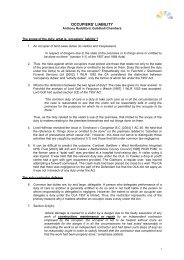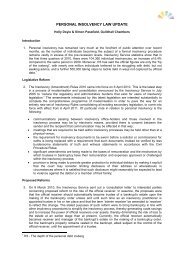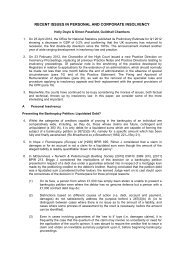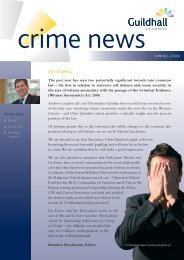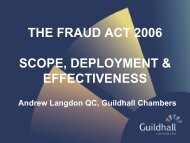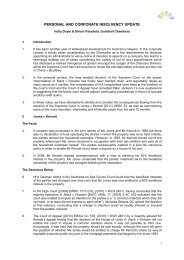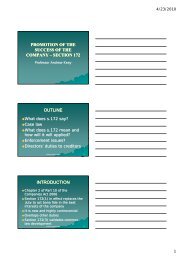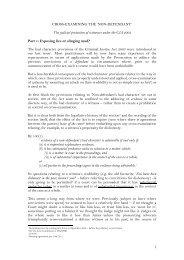Corporate Legal Upate - Stefan Ramel - Guildhall Chambers
Corporate Legal Upate - Stefan Ramel - Guildhall Chambers
Corporate Legal Upate - Stefan Ramel - Guildhall Chambers
You also want an ePaper? Increase the reach of your titles
YUMPU automatically turns print PDFs into web optimized ePapers that Google loves.
Insolvency Service, Area 5.6, 21 Bloomsbury Street, London WC1B3QW; or email to IPPolicy.Section@insolvency.gsi.gov.uk”He notified insolvency practitioners that:“The Service will be actively monitoring the timing of the notification tocreditors. Any failure to provide the required information to creditorsshould be the result of exceptional circumstances, and if this is thecase, the reason why the information is not provided should bestated.”6. Building on the SIP 16 disclosure reports to creditors which the Insolvency Service receivedpursuant to Stephen Leinster’s letter, in July 2009 the Insolvency Service released its Reporton the First Six Months Operation of Statement of Insolvency Practice 16. A further updatingreport is due to be published in the early part of 2010 (likely to be in March); as at the date ofwriting these notes, that updating report is not yet available. In the period January 2009 to endof June 2009, the Insolvency Service received reports in relation to 572 pre-packs. TheInsolvency Service Report estimates that, for the first three months of 2009, 29% ofadministrations involved a pre-pack. In the view of the Insolvency Service, of the 572 pre-packswhich were notified, only some 370 (65%) contained compliant SIP 16 disclosure. In 17 cases,the Insolvency Service has referred the matter to the individual insolvency practitioner’sregulatory body for further investigation, and if appropriate sanction. Further, the InsolvencyService Report records that 81% of “pre-pack” cases involved sales to parties connected withthe insolvent company. The main areas of deficiency have been identified by the InsolvencyService as relating to disclosure being made on a bullet-point basis, or being made late. On amore specific level, the areas in respect of which the SIP 16 reports fell short concerned theextent of the insolvency practitioner’s prior involvement with the company / the directors, aswell as in relation to the marketing and valuation activities undertaken by the insolvencypractitioner.7. The Insolvency Service Report, in places, has identified potential amendments to SIP 16 whichwill be the subject of a consultation exercise. Such suggestions have included adding amandatory requirement to provide the Secretary of State with a copy of the information.Another proposed amendment was to set out a more explicit timescale within which the SIP 16disclosure information must be supplied to creditors. The extent to which certain creditors of therelevant company held security over the assets of the company could well become anadditional area of SIP 16 disclosure.8. In October 2009, the Insolvency Service released issue 42 in the Dear IP series of letters whichwas devoted exclusively to pre-packs and SIP 16. It contains additional and detailed guidanceto insolvency practitioners involved in pre-pack cases. It starts with a reminder that, the wholepoint of SIP 16 is for creditors to be provided with a “detailed explanation and justification” ofwhy a pre-pack was appropriate. As pointed out in the Dear IP letter, “giving a short responseto the bullet point disclosure requirements … is unlikely to provide the detailed explanation andjustification required…”.The Insolvency Service has identified the following rule of thumb as ameans of assessing the sufficiency of information disclosed by the insolvency practitioner::“Practitioners should aim to provide sufficient information to ensurethat creditors do not need to ask further questions of the practitionerabout the justification for the pre-packaged sale and details of it.”Insofar as the timing of the SIP 16 disclosure is concerned, the Insolvency Service hasprovided much clearer guidance than is currently contained in SIP 16 itself:“It is expected that in the majority of cases SIP 16 information shouldbe sent to creditors within a few days of the practitioner’s appointmentor upon completion of the sale. In all but the most exceptional ofcases SIP 16 information should be sent to creditors within 14 days ofthe completion of the sale. If practitioners have been unable to meet2
this requirement they should explain the reasons for the delay in theirdisclosure.”The Dear IP letter also contains a substantial amount of additional guidance in respect ofseveral of the specific disclosure headings contained in paragraph 9 of SIP 16. These aresufficiently important to be reproduced in their entirety below:“The source of the practitioner’s initial introductionThe name of any introducer and their relationship to the companyand/or the directors, and the circumstances leading to the referral,form an integral aspect of the detailed explanation required forcreditors to understand the circumstances leading to the prepackagedsale and the context in which the practitioner becameinvolved. These details should, therefore, be disclosed under thisheading.Practitioners should also disclose the date of their formal engagementby the company when detailing their involvement.The extent of the practitioner’s involvement prior to appointmentSufficient information should be provided by practitioners to identifyany previous relationship between the practitioner (which shouldinclude the practitioner’s firm) and the company and/or directors.Many creditors will have only a limited understanding of formalinsolvency proceedings and an explanation that the practitioner, notthe directors, has undertaken the sale negotiations with theprospective appointment of an administrator in mind, may help toavoid misunderstandings.Any marketing activities conducted by the company and/or thepractitionerIn order for creditors to understand the circumstances leading to thepre-packaged sale, the practitioner should disclose details of theprocess that led to the decision to sell to the eventual purchaser. It isrecognised that the degree of marketing will vary on a case by casebasis and that practitioners will have considered many factors inreaching the decision to conduct any marketing exercise or, in somecases, not to market the business.Details of the nature of any marketing activities that were carried outby the company and/or practitioner should be provided or alternativelyan explanation provided as to why it was decided not to undertakeany marketing. If the business was marketed, and a number ofexpressions of interest and/or offers were received, it is important thatsummary information about the outcome of the marketing (such asthe number of offers received, the range of consideration offered andthe fact that the best offer was accepted) are disclosed, so that theoutcome of the marketing exercise is clear.”“Any valuations obtained of the business or the underlying assetsPractitioners will be aware of the importance of ensuring thatindependent valuations are carried out wherever possible. The levelof detail that practitioners will be able to provide will depend upon thetype of valuation that has been carried out and nature of the assets,but generally:3
• valuations should be disclosed with sufficient detail forcreditors to understand the values placed upon the variouscategories of assets. Where it is otherwise unclear,information should be provided as to how any value attributedto goodwill has been determined.• the basis upon which the business has been valued. Thismay include valuations on a going concern or break up basis,and any valuations of the underlying assets of the business,whether in-situ or ex-situ.• the name of the valuer used should be included in all cases.Where valuations have not been obtained by the practitioner anexplanation should be provided as to why not. Alternativelyinformation should be provided as to what reliance, if any, has beenplaced on valuations previously obtained by the company or itslender(s), such information being in the same format as above.”9. Without a doubt, the guidance contained in the Dear IP letter amounts to a considerabletightening of the SIP 16 disclosure requirements. Whereas before October 2009 it waspossible, without too much imagination, to avoid complying with the spirit of SIP 16 whilst stillcomplying with the letter of SIP 16, the same will be far harder to achieve post October 2009.The most obvious loopholes have snapped shut. Given the transparency objectives of SIP 16,Dear IP issue no 42 is to to be welcomed.10. Thus far, SIP 16 has generated two reported decisions in the High Court. His Honour JudgeCooke handed down judgment in Re Kayley Vending Limited [2009] EWCH 904 (Ch) [2009]BCC 578 on 15 May 2009; David Richards J handed down his judgment in ClydesdaleFinancial Services Limited & Ors v Smailes & Ors [2009] EWHC 1745 (Ch) on 18 June 2009.The Clydesdale litigation has also spawned a further case in relation to section 423 of theInsolvency Act 1986, which was also a decision of David Richards J [2009] EWHC 3190 (Ch)handed down on 8 December 2009 and which concerns the scope of the term “victim” for thepurposes of section 423, and is thus not directly relevant insofar as SIP 16 is concerned.11. HHJ Cooke in Kayley Vending was invited by counsel for the applicant to supply some generalguidance as to the court’s stance on SIP 16 in pre-pack cases where the applicant for anadministration order has decided that the company’s business will be sold in a pre-pack. Thejudge accepted that invitation and stated:“24. It seems to me that in exercising its discretion in pre-pack cases,the court must be alert to see, so far as it can, that the procedure is atleast not being obviously abused to the disadvantage of creditors inany of the ways outlined above. If it is, or may be, the court mayconclude that it is inappropriate to give the pre-pack the apparentblessing conferred by making the administration order. In reachingthat decision, it is likely to be assisted by the provision of informationin relation to the pre-pack transaction and its background, and to thatextent the provision of such information falls within rule 2.4(2)(e).While it is primarily a matter for the applicant to identify whatinformation is likely to assist the court, and that information may notbe limited to the matters identified in SIP 16, it seems to me likely thatin most cases the information required by SIP 16, insofar as known orascertainable at the date of application would fall within therequirement I have referred to and so ought to be included in theapplication. For the reasons given by Mr Morgan, it should notnormally be unduly burdensome or costly for it to be so included, andno doubt if there are special reasons why it cannot readily beprovided in a particular case this can be explained.”4
12. Smailes concerned the pre-pack sale of a law firm’s practice to a newco in early April 2009,thus after SIP 16 had come into force. Various secured and other creditors, who wereconsulted only moments before the sale took effect but without enough time to participate in thesale process, made a number of applications against the administrator (Mr Smailes) and thepre-pack purchaser (Jiva). Those applications were opposed by both the administrator and byJiva. The proceedings were, by all accounts, hotly contested. By the time of the final hearingbefore David Richards J, the sole substantive issue which remained live was whether or not theadministrators should be replaced. David Richards’ conclusion on that issue was expressed asfollows:30. This is not of course to say that any consideration or investigationwould finally disclose that there was anything untoward in relation tothe sale. It simply cannot be determined at this stage. What is,however, clear is that Mr Smailes and his firm were so closelyinvolved in the negotiations that he cannot be expected now toconduct an independent review. His case, it should be remembered,is that the price was negotiated by Coleman Coyle acting on hisinstructions and subject to his final approval. In this context it shouldalso be noted that a significant body of major creditors of LLPrepresenting a majority of the creditors in value, have expressed awish to see the removal of Mr Smailes and his co-administrator andthe appointment of the administrator proposed by CFS. For thereasons given above the concerns of those creditors are legitimateand as creditors their views, if reasonably held, are entitled toconsideration especially when it is recalled that the presentadministrators were appointed not by the creditors or the court but byMr Denenza. These grounds provide in my judgment proper basis onwhich the court could exercise its jurisdiction under paragraph 88 toremove the joint administrators. It is not, I wish to emphasise, a basiswhich involves any imputation against the integrity of theadministrators.”One of the grounds upon which the applicants in Smailes relied to secure the removal of theadministrators was a failure by the administrators to comply with SIP 16. David Richards J doesnot address that line of attack against the administrators in any detail (because it wasn’tnecessary for him to do so). He did not, however, suggest that a failure to comply with SIP 16could never be a ground for challenge. In terms, he stated:32. …. As to the notification to CFS I remain puzzled as to itspurpose. Mr Smailes in evidence says that he intended it to be infulfilment of SIP16 but it does not contain all the information requiredby SIP 16 and it was sent to only one creditor. This does nothowever, as I see it, provide a ground for his removal.34. Complaint is further made of the bland notification to creditors onthe 9th April 2009 by the administrators of their appointment whichreferred neither to the sale nor to the litigation by then underway, andof the letter sent on the 18th May 2009 in purported compliance withSIP 16. There are certainly some points to be made about theseletters but they are not of a sort which could justify the removal of theadministrators. In short I reject all the allegations of impropriety madeagainst the administrators but for the reasons already given groundsdo exist which would justify an exercise of the power of removal.”13. The introduction of SIP 16 has also generated a steadily growing corpus of articles andcommentaries in the general insolvency press and in specialist insolvency law journals. PhilipKing representing the creditor’s view in RECOVERY in Spring 2009 commented: “we believesomething needs to change. Although the new guidelines introduced at the beginning of theyear will help creditors understand who is involved and the nature of the difficulties the5
usiness was facing, suppliers are not closely involved enough”. He also makes the point that,SIP 16 does not require disclosure to creditors before the pre-pack; there is a risk therefore thatby the time that the SIP 16 disclosure comes to be made, the pre-pack has already beencompleted and the creditors are left with a fait accompli, albeit a well informed fait accompli.That theme is picked up in a piece by Ben Larkin an Ben Jones in the Summer 2009 edition ofRECOVERY, in which they make the point that, with a conventional CVA, creditors are involvedat an early stage and it is in theory possible for creditors to have a determinative say as towhether the CVA is approved. On the whole, such commentary on SIP 16 as there is has beenpositive. Mark Parkhouse and Kerry Scott, writing in the New Law Journal on 20 March 2009described SIP 16 as “a step in the right direction”. Andrew Carpenter, writing in the In HouseLawyer on 16 November 2009 saw the introduction of SIP 16 as a tacit approval by theauthorities of the pre-pack process; regulation rather than restriction was thus the watchword.Dr Sandra Frisby of the University of Nottingham is currently engaged in preparing empiricalresearch into pre-packs generally. In an article which appeared in the Winter 2009 edition ofRECOVERY she made a number of interesting observations in relation to SIP 16. It is worthbearing in mind that the period in respect of which she has received data is from September2001 to September 2006, thus before the introduction of SIP 16. However, she notes that, inthe latter part of that period, the level of disclosure by insolvency practitioners in pre-packcases had significantly improved, and moreover that, almost as a matter of routine, insolvencypractitioners were obtaining valuations of the business prior to the pre-pack. Her conclusionssupport an inference that, even before the introduction of SIP 16, insolvency practitioners,presumably in reaction to media comment, had begun self-regulating and presciently taking thesteps which would later be imposed on them by SIP 16.Recent and significant cases14. The period from July 2009 to January 2010 has generated a large volume of cases which eitherdirectly or indirectly concerned corporate insolvency procedures and laws. Time constraints donot allow for all of those cases to be digested in this paper and in the forthcoming talk; it hastherefore been necessary to select only a few of those recent cases. The selection criterionwhich has been adopted has been to focus on those cases which appeared to be the mostsignificant and also which haven’t been analysed in other sessions being given by colleaguesfrom <strong>Guildhall</strong> <strong>Chambers</strong> at the same seminar.(1) Mark Richard Phillips (2) Murzban Khurshed Mehta (as liquidator of Wilson Property UK Ltd) -v-Neil McGregor-Patterson [2009] EWHC 2385 (Ch), Henderson J, 2 October 200915. McGregor-Patterson came before Henderson J as an appeal by the defendant in the case (MrMcGregor-Patterson) from the decision of Deputy Master Farrington on an application forsummary judgment and / or strike out. The proceedings were started by the liquidators ofWilson Property UK Limited under Part 7 of the CPR seeking relief in respect of 3 categories ofpayments namely £54,700, £155,500 and £50,050. Some, but not all, of those payments hadbeen made directly to the defendant. There was no dispute that the defendant was, at allmaterial times, a director of the company. The cause of action upon which the liquidators reliedwas principally section 212 of the Insolvency Act 1986. Having said that, allegations were alsomade on the basis of section 239 to 241 of the Insolvency Act 1986, as well as sections 127and 214 of the Insolvency Act 1986. The company was a property development company whichrenovated barns in order to sell them at a profit as residential dwellings. The defendant,although a director of the company, was not the prime mover in the business (that was MrWilson); in fact, the defendant contended that he had had only a limited amount of involvementin the management of the business and he was supported in that assertion by the company’saccountant.16. In addition to mounting a substantive challenge to the Deputy Master’s judgment, the defendantput forward two technical arguments in support of his appeal, one of which can usefully bedigested here. The liquidators’ proceedings were started by a standard claim form under Part 7of the CPR in the Chancery Division instead of by way of an ordinary application under Chapter1 of Part 7 of the Insolvency Rules 1986. As a result, the defendant alleged that the liquidators’proceedings were irremediably and fatally flawed because the bespoke and mandatory formintended for such proceedings had not been used. Not surprisingly, the liquidators placed6
eliance on rule 7.55 of the Insolvency Rules 1986 which allows the court to declare thatinsolvency proceedings are not invalidated by any formal defect. Henderson J accepted thatthe liquidators’ proceedings were “insolvency proceedings” for the purposes of rule 7.55, andthat the defendant had not suffered any prejudice because the wrong form was used. Hewaived the defect and accordingly that technical argument failed.17. Henderson J allowed the appeal on substantive grounds. The defendant alleged that he onlyworked a few hours a month for the company, that he was based in London whereas thecompany was based in Peterborough and that he was not actually a signatory on thecompany’s account, and that by cumulating the above, there was at least an arguable basis forasserting that the defendant had not committed a breach of any fiduciary or other duty.Moreover, although he didn’t rely on it before the Deputy Master, it was argued on his behalf onappeal that the relieving jurisdiction contained in section 727 of the Companies Act 1985 wasengaged in the case, and could, at least arguably, be prayed in aid. In order to resolve suchissues, Henderson J was of the view that a full trial with live oral evidence was necessary.Further, and insofar as the claim under section 239 was concerned, it wasn’t, in Henderson J’sview, possible at a summary judgment stage to establish conclusively that the company wasactually insolvent or became insolvent as a result of the payments, and / or that the defendanthad failed to rebut the presumption that the company had been influenced in making thepayments by a desire to prefer the defendant. For those reasons, the appeal was allowed.McGregor Patterson is a salutary reminder to insolvency practitioners and their advisers of thedangers of seeking to obtain summary judgment on claims alleging breach of fiduciary duty and/ or preferential payments.In the matter of Equilift Limited [2009] EWHC 3104 (Ch), His Honour Judge Purle QC, 27 November200918. In late 2009, HHJ Purle QC heard an application for directions by the joint liquidators of EquilifitLimited, a company which was concerned in the supply and installation of stair lifts prior to itgoing into administration which was followed by liquidation. The company held severalaccounts into which it paid income from the business, including sums paid to it by way of prepaymentor deposits for goods which the company was due to supply. Unfortunately, it seemsthat the company was not particularly assiduous at keeping track of which sums related todeposits and pre-payments, so much so that, when the company eventually enteredadministration, there was a considerable measure of doubt as to whether particular customerscould advance proprietary claims against the company. HHJ Purle QC, as well as theliquidators and their solicitors had a firm eye on the clear risk in Equilift that, if substantivelitigation were to be initiated whereby individual customers were required to prove their claims(or appoint representative parties to do that for them), because the liquidators, as neutralparties would most likely be awarded an indemnity for their legal costs out of the estate, thesum which would be leftover for creditors would be very small indeed. According to thejudgment of his HHJ Purle QC, the amount standing to the credit of the bank accounts was£171,784.35, whereas a total of 484 customers were potentially concerned. Further, theliquidators were also keenly aware that, by paying out sums from the company’s bank accountwhich might potentially be subject to proprietary claims in favour of third parties, they would beopening themselves to allegations of breach of trust.19. HHJ Purle QC identified and then adopted a pragmatic solution to this apparent impasse. Heinvited Mohammed Zaman QC, who was instructed on behalf of the liquidators, to prepare andfile in court a written opinion on the question of whether or not any proprietary rights actuallyexisted in any of the funds held in the bank accounts. Upon that advice being filed in court, itwould then be possible for the judge, on a non-adversarial basis, to take stock of the position.In the events which happened, counsel concluded that there were no proprietary claims (savefor one small amount) and therefore the liquidators could treat the sums available in the bankaccount as being payable to the general body of creditors, provided that all affected customerswere informed of their right to obtain and review a copy of the judgment, the application andevidence in support, including counsel’s opinion. After two months elapsed from the date ofsuch notification, and provided that no customers have written to notify any objections, then theliquidators would be empowered to distribute the sums which they held. Equilift is a good7
example of a court seeking and implementing a pragmatic and cost effective solution to apotentially difficult situation. Moreover, there was a plain additional benefit to the office holderssince, by his tacit endorsement of the strategy of obtaining and relying on counsel’s opinion, thejudge has made it very hard for any potentially interested third party to successfully challenge(by alleging a breach of trust) the liquidators’ conduct.Parkinson Engineering Services Plc (in liquidation) -v- (1) Julie Swann (2) Peter Yeldon [2009] EWCACiv 1366, Court of Appeal (Lloyd, Sedley, Sullivan LJJ) 21 December 200920. Parkinson Engineering Services Plc was initially placed in administration by Laddie J on 7 May2003. The two defendants, Julie Swann and Peter Yeldon were appointed as administrators ofthe company. Their appointment lasted only for some months since they were discharged byPark J on 14 November 2003, on terms that, provided no claims were made against them by 13February 2004, that they should have their release on that date pursuant to section 20 of theInsolvency Act 1986. Mr Abdulali was appointed as the liquidator of the company some timethereafter. On 17 April 2009, he procured the company to commencing litigation against the twoformer administrators alleging negligence and seeking damages in the sum of £1,968,780. Thetwo defendants responded by alleging that the proceedings against them were time barredhaving regard to the release which they obtained from Park J; this was met by an application bythe liquidator to substitute himself as the claimant in place of the company since he could thenrely on section 212 of the Insolvency Act 1986, which, pursuant to section 20(3) of theInsolvency Act 1986, would allow him to circumvent the release granted by Park J. At firstinstance, Floyd J allowed the liquidator’s application. The two defendants appealed to the Courtof Appeal.21. In the Court of Appeal, Lloyd LJ dismissed the appeal and upheld the decision of Floyd J. Thethreshold issued was posed by a combination of section 35(5)(b) of the Limitation Act 1980 andCPR rule 19.5: is the addition or substitution of a new party necessary for the determination ofthe original action? The main argument put forward on behalf of the defendant was that,because the original claim was statute barred, it could not actually be maintained, and sotherefore it wasn’t necessary to add or substitute any party. Further, it was also suggested thatthe causes of action were not the same, and so therefore an addition or substitution could notbe allowed. The liquidator’s position before the Court of Appeal was that the negligence claimby the company and the section 212 claim by the liquidator were identical, indeed, theproposed changes did not include any amendments to the allegations of duty, breach or loss,and that it could therefore be allowed. Lloyd LJ concluded that the substitution was necessaryin Parkinson Engineering Services Plc, and that for that reason, it was appropriate to allow theliquidator’s application. Without substitution, the claim could never be determined on its merits.<strong>Stefan</strong> <strong>Ramel</strong><strong>Guildhall</strong> <strong>Chambers</strong>, BristolJanuary 20108




